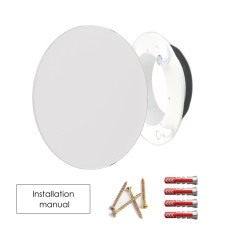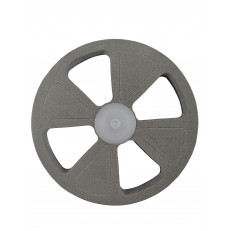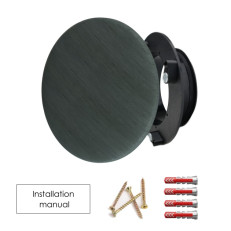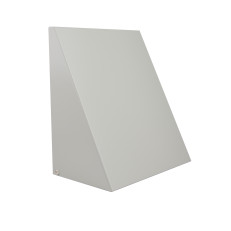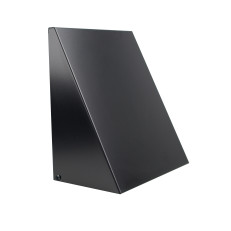How to choose a recovery unit? 8 features that should interest you

When choosing a central ventilation unit with heat recovery for a family house or apartment, it is important to consider several key parameters so that it meets your needs. We have prepared for you the 8 most important points on which it is good to focus.
1. Air performance
The unit should have enough power to exchange stale air for fresh air throughout the house. This performance is most often given in m³/h (cubic meters per hour). A simple standard requirement (ČSN EN 15665 Z-1) is the recommended value of the ventilation intensity. This stipulates the necessary replacement of the entire volume of air in the house at least once every two hours, and at the same time it is supposed to ensure a dose of fresh air for each person min. 25 m³/h. We are happy to advise you on the calculation of the recommended value of the air in the room or you can find it in your air-conditioning project. We advise our clients to choose a unit with a maximum performance of min. 75 m³/h higher than the recommended value of the ventilation intensity . The maximum power of the unit is always indicated on the energy label of the unit.
!!! OUR TIP:
When choosing a unit, always consider the pressure loss of the system. The usual pressure loss in family houses is up to 100 Pa. However, if you install e.g. hot water exchanger, additional filtration, pipe humidifier or you use an inappropriate size of air ducts or outlet, the pressure loss will increase and you will need a more powerful unit. We will be happy to help you determine the pressure loss of distributions.
2. Efficiency of recovery
It indicates how much heat the recuperation unit is able to capture from the outgoing air and return it back to the house. Higher efficiency means lower heat loss and better energy saving. Today, efficiencies above 85% are common for central ventilation units.
We have already written more here Recuperator and efficiency of recuperation - Luftuj.cz
!!! OUR TIP:
If you want to compare the recovery efficiency of different units, it is advisable to always compare it at the same air flow rate. Efficiency varies significantly with flow rate. The lower the air flow, the higher the recovery efficiency is usually. At the same time, this information value is only true if the mass flow of air at the inlet and outlet is perfectly balanced.
3. Noise
Noise parameters are important, especially if the unit will be located near living spaces such as a bedroom or children's room. The sound power level (LWA) is given in dB. You can easily compare the noise to the surroundings from the energy label. Pipeline noise (intake, exhaust, intake, exhaust) can usually only be detected by experts with access to the manufacturer's software. Thanks to this, the designer can design suitable dampers and other distribution components that eliminate the noise spreading through the pipe.
!!! OUR TIP:
If you are comparing ambient noise, be careful that you are comparing the same values. The manufacturer states the values on the casing as well as the values measured 3 m from the unit. The sound power value changes with the actual power of the unit. Here too, the rule applies that a stronger unit brings advantages. If you can run the unit at smaller percentages of its maximum output, it will make less noise.
4. Energy intensity
The manufacturer is obliged to indicate how much energy the unit consumes using three indicators:
The energy efficiency can be easily compared according to the two values given by the manufacturer.
Class of energy efficiency - a relatively complex calculation is hidden behind the inclusion in class A+, A, B.... It is not always fair and corresponds to reality. It considers, for example, system regulation options that may not be used by the designer or user at all. Therefore, the difference between a unit classified in the energy efficiency class A and A+ may not be any in your particular case.
SEC is the specific energy consumption for ventilation per 1 m 2 of the heated floor area of an apartment or building - the whole number is again a long calculation and is further divided according to the type of climate in which the unit is used.
Specific power input (SPI) - is stated in W/(m 3 /h). In a simplified way, it determines how many watts the unit consumes in order for 1m 3 /h to flow through it.
Modern recuperation units are often equipped with energy-saving fans with low electricity consumption. Energy efficiency class A or A+ is ideal.
5. Air filtration
The quality of the filters and their availability is also an important factor. Filters ensure that our unit lasts as long as possible and that dust and other substances do not get into our household. All units are equipped with at least dust filters for the suction from the outdoor area and the exhaust branch from the house.
Make sure that the unit has filters of a level that is suitable for you (not only from the point of view of allergies, dirt in the surroundings, but also later acquisition costs). Expect that you will have to change the filters at least every 3 months. Check the prices in our e-shop FILTERS - Luftuj.cz and we have already written more about filters here: Filters for recuperation - Luftuj.cz
6. Possibility of control and regulation
Consider whether you want a unit that can be controlled via a smartphone or integrated into a smart home system. Modern recovery units often allow automatic modes to be set depending on humidity or CO₂ concentration.
Find out how the unit uses the boost buttons and if they can be programmed. Many clients appreciate the ability to control ventilation using time modes or other inputs.
For passive houses and especially wooden buildings, we recommend Constant Flow control as suitable.
7. Size and space for installation
Check the dimensions and space where the unit will be placed. Some systems may require sufficient space to access filters and other service parts. We will be happy to show you how big the unit is in real life in our showroom in Slatiňany or watch our video.
8. Additional features
Some units have added features such as bypass (summer operation without heat recovery), enthalpy exchangers (for moisture recovery) or air cooling options in summer.
That's a lot to focus on, and each unit has its pros and cons. You can always consult our technician on which unit to choose at info@luftuj.cz or by phone - infoline

